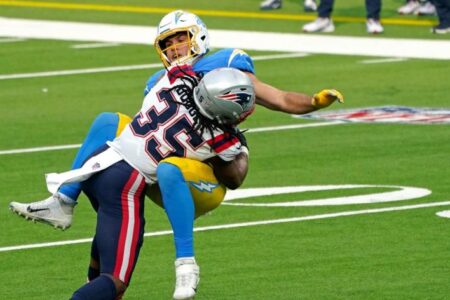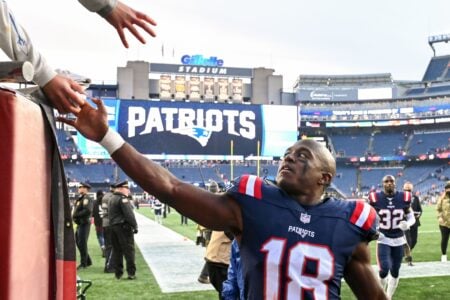Kickoff Coverage II: Spears and Gunners
"Stay in your lane."
For decades, those words have been the foundation of every football coach's instructions to the players on his kickoff coverage unit. In the early days of football, the members of the coverage team just lined up across the field with five yards between them, then ran straight downfield and made sure that if the return man ran within their five-yard lane, they tackled him.
But as football strategy has progressed, kickoff coverage has become significantly more complex than simply telling the 10 men on the coverage team (excluding the kicker, whose job is to pray that he doesn't have to make a tackle), to stay in their lanes. If each of the 10 men care only about an area of real estate just over five yards wide, the kickoff return team's wedge would overpower the players in the center lanes and lead a long return up the middle every time.
In this edition of our off-season strategy minicamp, we'll look at the responsibilities of the 10 players on the kickoff coverage team. Although it might seem like each player's job is as simple as "stay in your lane," or, alternatively, "just run downfield and tackle the guy with the ball," kickoff coverage teams have specific roles, which we'll address here.
Unlike on offense or defense, where everyone can agree what a quarterback is or what a linebacker is, on kickoff coverage, different teams use different terms to describe the players on the field. Special teams coaches like their coverage players to have somewhat reckless attitudes, which is why kickoff coverage players often have positions with names like "wedge buster," "spear," "bomber," and "gunner." For the purposes of this article we'll mostly identify coverage players using the simple system of R1 through R5 and L1 through L5, with the player closest to the kicker on the kicker's right identified as R1 and the player closest to the sideline on the kicker's left as L5.
Kickoff coverage players have four basic responsibilities:
1. Line up at the 20-yard line and time their run perfectly with the kicker's approach so that they are running at full speed and close to the 30-yard line as possible (without crossing it) just as the kicker's foot touches the ball.
2. Evade the front line. As we wrote about in our previous installment, kickoff return teams have two groups of blockers, the front line and the wedge. Getting past the front line blocks requires some of the same speed rush moves that defensive ends use on offensive tackles. An arm rip or a swim technique can help a coverage player get past the front line blockers without having to slow down.
3. Attack the wedge. Think of all the defensive tackles who have long and productive NFL careers not because they tackle the ball carrier themselves very often but because they can take on blockers to give the linebackers behind them space to make the tackle. Wedge busters are smaller and faster than defensive tackles but have similar roles on the team. They need to make sure the return unit doesn't have a perfectly intact wedge that can escort the return man to the end zone.
4. Make the tackle. No matter how quickly a coverage player can get downfield, if he allows the return man to run past him, he isn't of much use to his team.
Linebackers, defensive backs and wide receivers make up the bulk of the kickoff coverage teams because they have the right combination of speed to get downfield, elusiveness to avoid the blocks, and tackling ability. Among the league's best kickoff coverage players are Atlanta Falcons linebacker Ike Reese, Pittsburgh Steelers receiver Sean Morey, and New York Giants receiver David Tyree.
On a typical coverage unit, R5 and L5 are the gunners � their job is to run straight to the ball. Because they're coming from the sidelines and the wedge usually assembles in the middle of the field, they usually don't have to worry about No. 3 of the above responsibilities. When the gunners do their jobs perfectly, they fly past the opposing front line and around the wedge, and then tackle the return man before he can reach the 20-yard line. Gunners line up at one 20-yard line and sprint to the other, a 60-yard run that is about the farthest a football player ever runs in a straight line.
Because R5 and L5, the players closest to the sideline, are running straight to the ball, there's a risk that the returner can run past them and simply turn up the sideline and take it to the house. That's why most teams give R4 and L4 the job of containment along the sidelines. R4 and L4 cross paths with L5 and R5 and make sure that if the return man tries to run up the sideline, they either tackle him or force him to turn back inside, where one of their teammates can make the tackle.
Responsibility No. 3, commonly known as the wedge buster, generally goes to L1 and R1. They're the players closest to the middle of the field, so they've got a straight shot at the opposing wedge. This is the perfect job for a rookie linebacker who has good speed and aggressiveness but hasn't learned the nuances of reading an opposing offense yet, or to a rookie fullback who loves running head first into someone in the opposite color jersey but doesn't fully understand how to identify a blitz. The coaches simply tell L1 and R1 to run full speed into the crowd of opposing blockers to foul up the return game. The wedge busters don't need to make the tackle themselves, but they need to make sure the opposing blockers are otherwise occupied. Many of the best wedge busters take out two blockers at once by throwing themselves at the wedge using a sideways leap, taking out one member of the wedge with the shoulders and another one with the hips.
That leaves L2, L3, R2 and R3 as the players who usually make the tackle. Those four players still have the role of staying in their lanes, but as they're running down the field in their lanes, they need to keep an eye on the ball, to see where the kick has gone and which direction the returner is going. One problem that often comes up, especially for players who try to break into the NFL on kickoff coverage units but didn't play special teams in college, is that they tend to keep their heads down when running. The players on the kickoff coverage unit need to have their heads up and be on the lookout both for the players trying to block them and for where the return man is running.
Television camera angles make the kickoff coverage unit look like vaguely organized chaos. That's not an entirely inaccurate description of what's happening on the field. But players on the kickoff coverage units spend hours watching film and studying the Xs and Os on the blackboard for a reason. Within that seeming chaos, each of the 10 men on the kickoff coverage unit has a specific job that he needs to execute with every bit the precision of a quarterback's seven-step drop or a safety's blitz. Covering a kickoff doesn't get a player's face on television, but it does help his team win.


















